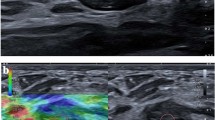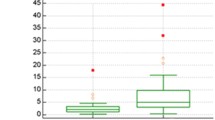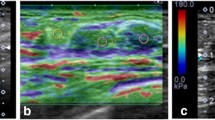Abstract
Purpose
To investigate whether a novel method that combines breast imaging reporting and data system (BI-RADS) with strain elastography contributes to diagnostic performance in differentiation of malignant and benign breast lesions.
Methods
In 81 patients, 81 breast lesions were prospectively investigated. Breast lesions were separately evaluated with ultrasonography and strain elastography. While evaluations with ultrasonography were based on 2003 BI-RADS-US, strain elastography evaluations were based on a 5-point scale and strain ratio. Diagnostic performances of ultrasonography, strain elastography, and the combined method were compared.
Results
Among 81 lesions, 43 (53.1%) were benign and 38 (46.9%) were malignant. When a cutoff point of category 3 was used, sensitivity, specificity, positive and negative predictive values, and accuracy for BI-RADS were 100, 11.6, 50, 100, and 53%, respectively. When BI-RADS and strain ratio were combined, sensitivity, specificity, positive and negative predictive values, and accuracy were 89.5, 93, 91.9, 90.9, and 91.3%, respectively. When BI-RADS and elastography scores were combined, sensitivity, specificity, positive and negative predictive values, and accuracy were 86.8, 97.7, 97.1, 89.4, and 92.5%, respectively.
Conclusions
The combination of strain elastography and BI-RADS was found to have better diagnostic performances to diagnose breast lesions than BI-RADS alone.



Similar content being viewed by others
References
Botha JL, Bray F, Sankila R, et al. Breast cancer incidence and mortality trends in 16 European countries. Eur J Cancer. 2003;39:1718–29.
Margolin FR, Leung JW, Jacobs RP, et al. Percutaneous imaging-guided core breast biopsy: 5 years’ experience in a community hospital. AJR Am J Roentgenol. 2001;177:559–64.
Wiratkapun C, Bunyapaiboonsri W, Wibulpolprasert B, et al. Biopsy rate and positive predictive value for breast cancer in BI-RADS category 4 breast lesions. J Med Assoc Thai. 2010;93:830–7.
Hao SY, Ou B, Li LJ, et al. Could ultrasonic elastography help the diagnosis of breast cancer with the usage of sonographic BI-RADS classification? Eur J Radiol. 2015;84:2492–500.
Ophir J, Cespedes I, Ponnekanti H, et al. Elastography: a quantitative method for imaging the elasticity of biological tissues. Ultrason Imaging. 1991;13:111–34.
Itoh A, Ueno E, Tohno E, et al. Breast disease: clinical application of US elastography for diagnosis. Radiology. 2006;239:341–50.
Stavros AT, Thickman D, Rapp CL, et al. Solid breast nodules: use of sonography to distinguish between benign and malignant lesions. Radiology. 1995;196:123–34.
Hao SY, Jiang QC, Zhong WJ, et al. Ultrasound Elastography Combined With BI-RADS-US Classification System: Is It Helpful for the Diagnostic Performance of Conventional Ultrasonography? Clin Breast Cancer. 2016;16:e33–41.
Chaiwerawattana A, Thanasitthichai S, Boonlikit S, et al. Clinical outcome of breast cancer BI-RADS 4 lesions during 2003-2008 in the National Cancer Institute Thailand. Asian Pac J Cancer Prev. 2012;13:4063–6.
Yoon JH, Kim MJ, Moon HJ, et al. Subcategorization of ultrasonographic BI-RADS category 4: positive predictive value and clinical factors affecting it. Ultrasound Med Biol. 2011;37:693–9.
Zhi H, Xiao XY, Ou B, et al. Could ultrasonic elastography help the diagnosis of small (≤2 cm) breast cancer with the usage of sonographic BI-RADS classification? Eur J Radiol. 2012;81:3216–21.
Cho N, Moon WK, Kim HY, et al. Sonoelastographic strain index for differentiation of benign and malignant nonpalpable breast masses. J Ultrasound Med. 2010;29:1–7.
Parajuly SS, Lan PY, Yun MB, et al. Diagnostic potential of strain ratio measurement and a 5 point scoring method for detection of breast cancer: Chinese experience. Asian Pac J Cancer Prev. 2012;13:1447–52.
Zhao QL, Ruan LT, Zhang H, et al. Diagnosis of solid breast lesions by elastography 5-point score and strain ratio method. Eur J Radiol. 2012;81:3245–9.
Zhi H, Xiao XY, Yang HY, et al. Ultrasonic elastography in breast cancer diagnosis: strain ratio vs 5-point scale. Acad Radiol. 2010;17:1227–33.
Fausto A, Rubello D, Carboni A, et al. Clinical value of relative quantification ultrasound elastography in characterizing breast tumors. Biomed Pharmacother. 2015;75:88–92.
Fischer T, Peisker U, Fiedor S, et al. Significant differentiation of focal breast lesions: raw data-based calculation of strain ratio. Ultraschall Med. 2012;33:372–9.
Zhou J, Zhan W, Dong Y, et al. Stiffness of the surrounding tissue of breast lesions evaluated by ultrasound elastography. Eur Radiol. 2014;24:1659–67.
Chang JM, Won JK, Lee KB, et al. Comparison of shear-wave and strain ultrasound elastography in the differentiation of benign and malignant breast lesions. AJR Am J Roentgenol. 2013;201:W347–56.
Li DD, Xu HX, Guo LH, et al. Combination of two-dimensional shear wave elastography with ultrasound breast imaging reporting and data system in the diagnosis of breast lesions: a new method to increase the diagnostic performance. Eur Radiol. 2016;26:3290–300.
Houelleu Demay ML, Monghal C, Bertrand P, et al. An assessment of the performance of elastography for the investigation of BI-RADS 4 and BI-RADS 5 breast lesions: correlations with pathological anatomy findings. Diagn Interv Imaging. 2012;93:757–66.
Durur-Karakaya A, Durur-Subasi I, Akcay MN, et al. Sonoelastography findings for idiopathic granulomatous mastitis. Jpn J Radiol. 2015;33:33–8.
Author information
Authors and Affiliations
Corresponding author
Ethics declarations
This study was supported by the Research Fund of Medical School of Baskent University, Ankara, Turkey.
Conflict of interest
The authors declare that they have no conflict of interest.
Research involving human participants and/or animals
All procedures followed were in accordance with the ethical standards of the responsible committee on human experimentation (institutional and national) and with the Helsinki Declaration of 1964 and later versions.
Informed consent
Informed consent was obtained from all patients for being included in the study.
About this article
Cite this article
Arslan, S., Uslu, N., Ozturk, F.U. et al. Can strain elastography combined with ultrasound breast imaging reporting and data system be a more effective method in the differentiation of benign and malignant breast lesions?. J Med Ultrasonics 44, 289–296 (2017). https://doi.org/10.1007/s10396-017-0772-y
Received:
Accepted:
Published:
Issue Date:
DOI: https://doi.org/10.1007/s10396-017-0772-y




